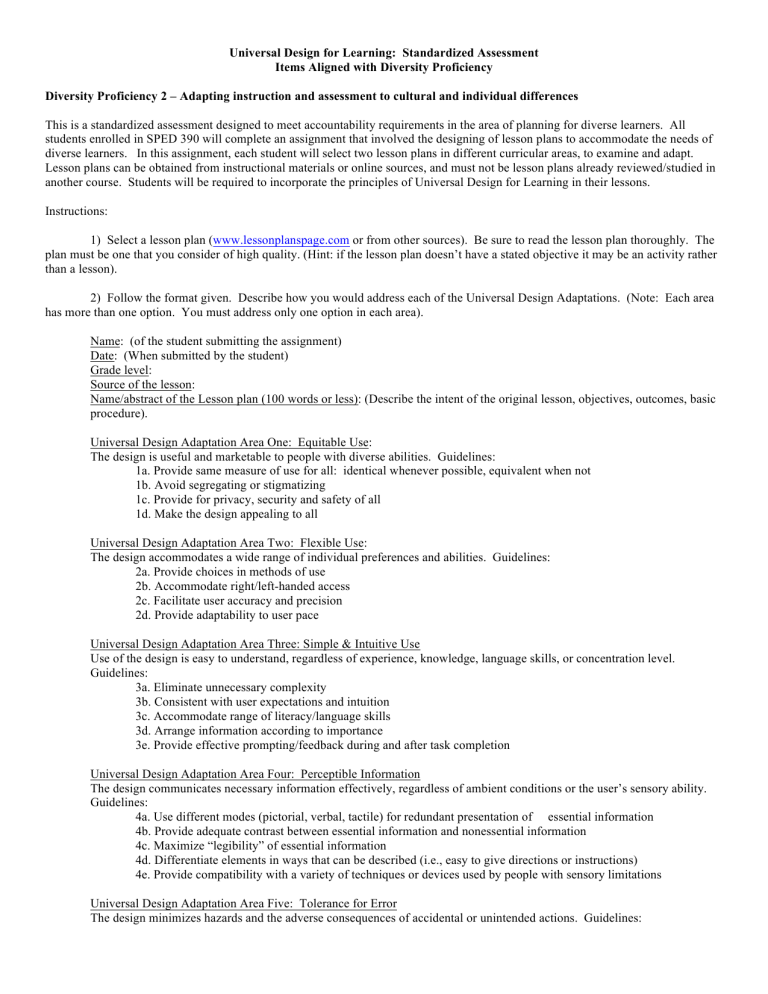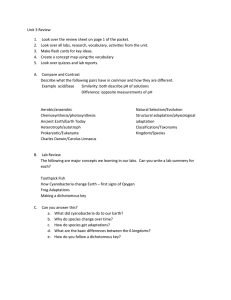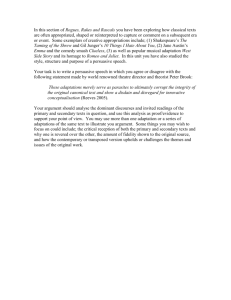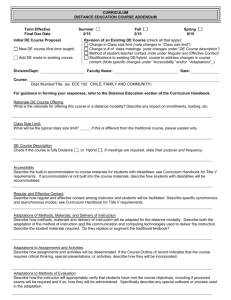Universal Design for Learning: Standardized Assessment

Universal Design for Learning: Standardized Assessment
Items Aligned with Diversity Proficiency
Diversity Proficiency 2 – Adapting instruction and assessment to cultural and individual differences
This is a standardized assessment designed to meet accountability requirements in the area of planning for diverse learners. All students enrolled in SPED 390 will complete an assignment that involved the designing of lesson plans to accommodate the needs of diverse learners. In this assignment, each student will select two lesson plans in different curricular areas, to examine and adapt.
Lesson plans can be obtained from instructional materials or online sources, and must not be lesson plans already reviewed/studied in another course. Students will be required to incorporate the principles of Universal Design for Learning in their lessons.
Instructions:
1) Select a lesson plan ( www.lessonplanspage.com
or from other sources). Be sure to read the lesson plan thoroughly. The plan must be one that you consider of high quality. (Hint: if the lesson plan doesn’t have a stated objective it may be an activity rather than a lesson).
2) Follow the format given. Describe how you would address each of the Universal Design Adaptations. (Note: Each area has more than one option. You must address only one option in each area).
Name: (of the student submitting the assignment)
Date: (When submitted by the student)
Grade level:
Source of the lesson:
Name/abstract of the Lesson plan (100 words or less): (Describe the intent of the original lesson, objectives, outcomes, basic procedure).
Universal Design Adaptation Area One: Equitable Use:
The design is useful and marketable to people with diverse abilities. Guidelines:
1a. Provide same measure of use for all: identical whenever possible, equivalent when not
1b. Avoid segregating or stigmatizing
1c. Provide for privacy, security and safety of all
1d. Make the design appealing to all
Universal Design Adaptation Area Two: Flexible Use:
The design accommodates a wide range of individual preferences and abilities. Guidelines:
2a. Provide choices in methods of use
2b. Accommodate right/left-handed access
2c. Facilitate user accuracy and precision
2d. Provide adaptability to user pace
Universal Design Adaptation Area Three: Simple & Intuitive Use
Use of the design is easy to understand, regardless of experience, knowledge, language skills, or concentration level.
Guidelines:
3a. Eliminate unnecessary complexity
3b. Consistent with user expectations and intuition
3c. Accommodate range of literacy/language skills
3d. Arrange information according to importance
3e. Provide effective prompting/feedback during and after task completion
Universal Design Adaptation Area Four: Perceptible Information
The design communicates necessary information effectively, regardless of ambient conditions or the user’s sensory ability.
Guidelines:
4a. Use different modes (pictorial, verbal, tactile) for redundant presentation of essential information
4b. Provide adequate contrast between essential information and nonessential information
4c. Maximize “legibility” of essential information
4d. Differentiate elements in ways that can be described (i.e., easy to give directions or instructions)
4e. Provide compatibility with a variety of techniques or devices used by people with sensory limitations
Universal Design Adaptation Area Five: Tolerance for Error
The design minimizes hazards and the adverse consequences of accidental or unintended actions. Guidelines:
5a. Arrange elements to minimize hazards and errors: most-used elements, most accessible, hazardous elements eliminated, isolated or shielded.
5b. Provide warnings of hazards and errors
5c. Provide fail safe features
5d. Discourage unconscious action in tasks that required vigilance
Universal Design Adaptation Area Seven: Size and Space:
7a. Provide a clear line of sight to important elements for any seated or standing user
7b. Make reach to all components comfortable for any seated or standing user
7c. Accommodate variations in hand and grip size
7d. Provide adequate space for use of assertive devices or personal assistance
Adapted Assessment Option One:
Creativity is encouraged with Assessments. Avoid paper and pencil assessments completed by an individual. Assessment could be in the form of a performance, activity, completed by teams or pairs of students, etc.
Scoring Guide:
The following rubric is used to evaluate the Universal Design Project:
Using the Principles of Universal Design to Accommodate All Learners
Indicator
Area One: Equitable Use Adaptations provided for the lesson plan are lacking,
Area Two:
Flexible Use
Area Four: Perceptible
Information
Unacceptable (1) inappropriate, and/or incomplete.
Adaptations provided for the lesson plan are lacking, inappropriate, and/or incomplete.
Adaptations provided for the lesson plan are lacking, inappropriate, and/or incomplete.
Acceptable (2)
Adaptations provided for the lesson plan are appropriate and complete.
Adaptations provided for the lesson plan are appropriate and complete.
Adaptations provided for the lesson plan are appropriate and complete.
Target (3)
Adaptations provided for the lesson plan are thoughtful and/or creative, appropriate and complete.
Adaptations provided for the lesson plan are thoughtful and/or creative, appropriate and complete.
Adaptations provided for the lesson plan are thoughtful and/or creative, appropriate and complete.
Area Five: Tolerance for
Error
Adaptations provided for the lesson plan are appropriate and complete.
Area Seven: Size and
Space
Assessment
Adaptations provided for the lesson plan are lacking, inappropriate, and/or incomplete.
Adaptations provided for the lesson plan are lacking, inappropriate, and/or incomplete.
Failed to provide a reasonable change or modification to the assessment component of the lesson plan.
Adaptations provided for the lesson plan are appropriate and complete.
Provided at least one reasonable change or modification to the assessment component of the lesson plan.
Adaptations provided for the lesson plan are thoughtful and/or creative, appropriate and complete.
Adaptations provided for the lesson plan are thoughtful and/or creative, appropriate and complete.
Provided two or more reasonable changes or modifications to the assessment component of the lesson plan.







